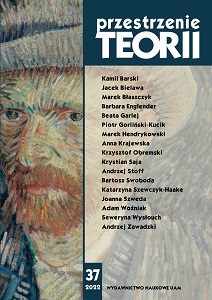Literaturoznawcza analiza/interpretacja krytyczna: Józef Tischner Myślenie z wnętrza metafory versus Bartłomiej Maliszewski Metafora i aksjologia wzorzec człowieka w renesansowej literaturze parenetycznej
A Literary Critical Analysis/Interpretation: Józef Tischner Myślenie z wnętrza metafory (Thinking From Within the Metaphor) versus Bartłomiej Maliszewski Metafora i aksjologia wzorzec człowieka w renesansowej literaturze parenetycznej (Metaphor and
Author(s): Krzysztof ObremskiSubject(s): Studies of Literature, Theory of Literature, Stylistics
Published by: Uniwersytet Adama Mickiewicza
Keywords: metaphor; axiology; parenesis; man;
Summary/Abstract: Józef Tischner’s Myślenie z wnętrza metafory [Thinking From Within the Metaphor] and Bartłomiej Maliszewski’s Metafora i aksjologia [Metaphor and Axiology] are texts that are both described (analysed) and interpreted here. However, the debatability of the dual understanding of metaphor (‘inside’ – ‘outside’) is only a preliminary difficulty. For it will be incomparably more important that when we read Thinking From Within the Metaphor, then we will not find an explanation of the authorial meaning attributed to the after all key term of his text, and this is by no means a coincidence. The fundamental opposition – unambiguous genre language versus axiological and agathological analogical (metaphorical, symbolic) language – is certainly a persuasive construction, but not necessarily a valid one. A fundamental literary problem: is the Platonic cave really a metaphor? In Bartłomiej Maliszewski’s book Metafora i aksjologia wzorzec człowieka w renesansowej literaturze parenetycznej [Metaphor and Axiology. The Model of Man in Renaissance Parenetic Literature], ‘metaphor’ is equated with the ‘figurative’. There would be nothing reprehensible in this if not for the fact that these two key terms in the book co-create a state of approximate numerical equilibrium, while (and this is more important) proving to be both identical and disjointed. The lack of a definition of ‘metaphor’ and ‘figurative’ makes the whole impressive argument resemble a colossus standing on two legs of clay, over which it stumbles as they become entangled. The legitimacy of the combined view of Thinking From Within the Metaphor and Metaphor and Axiology is contained primarily in the fact that Renaissance parenesis can be seen as one of the historical forms of agathology.
Journal: Przestrzenie Teorii
- Issue Year: 2022
- Issue No: 37
- Page Range: 275-290
- Page Count: 16
- Language: Polish

